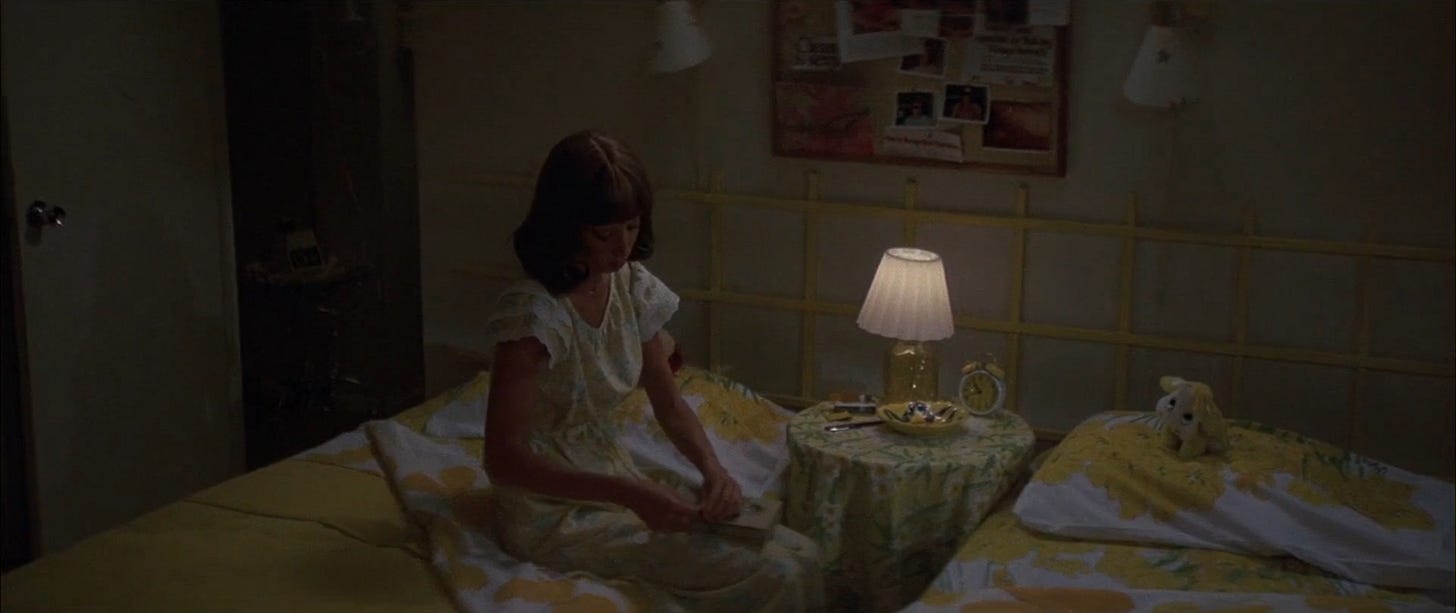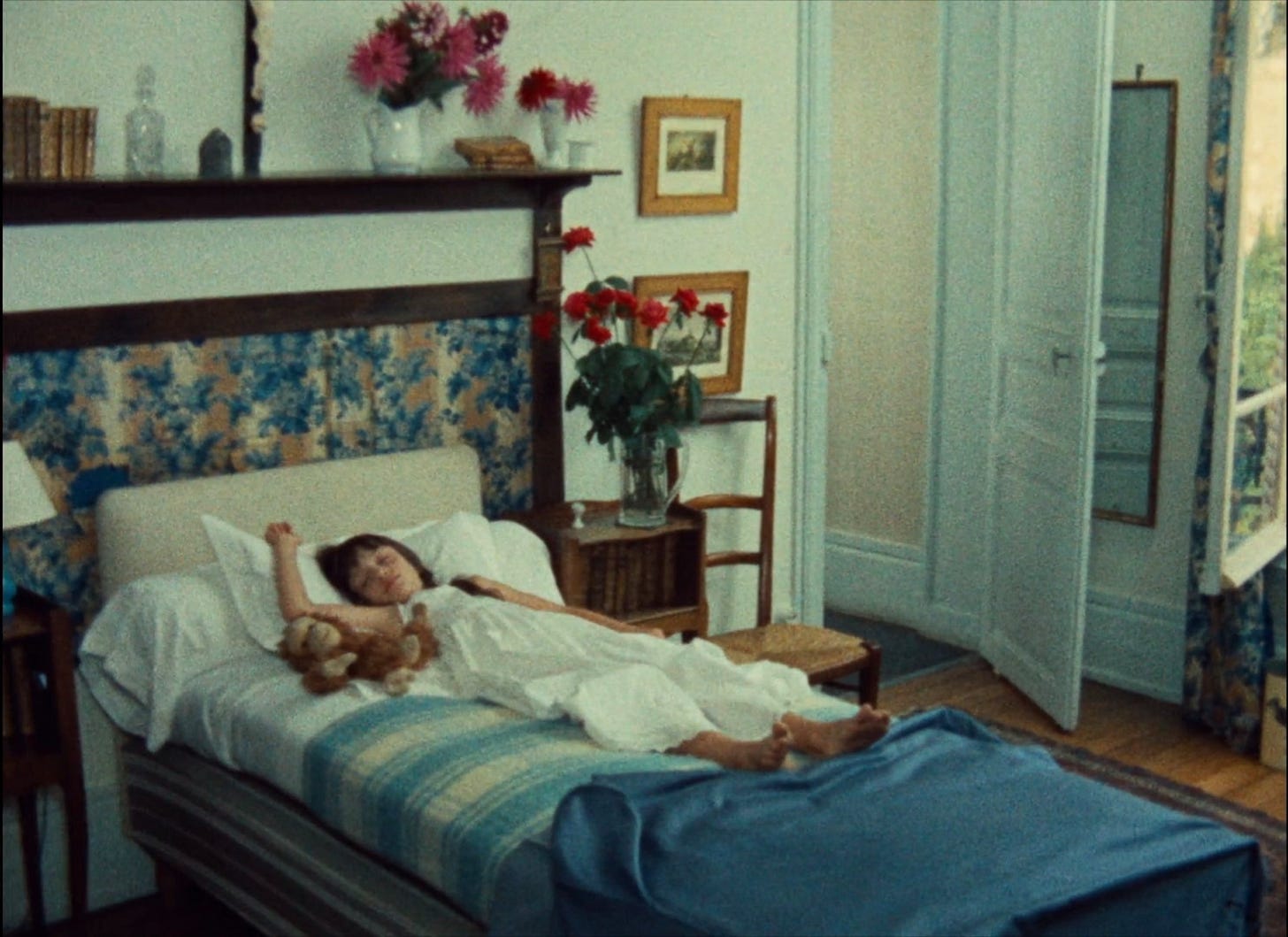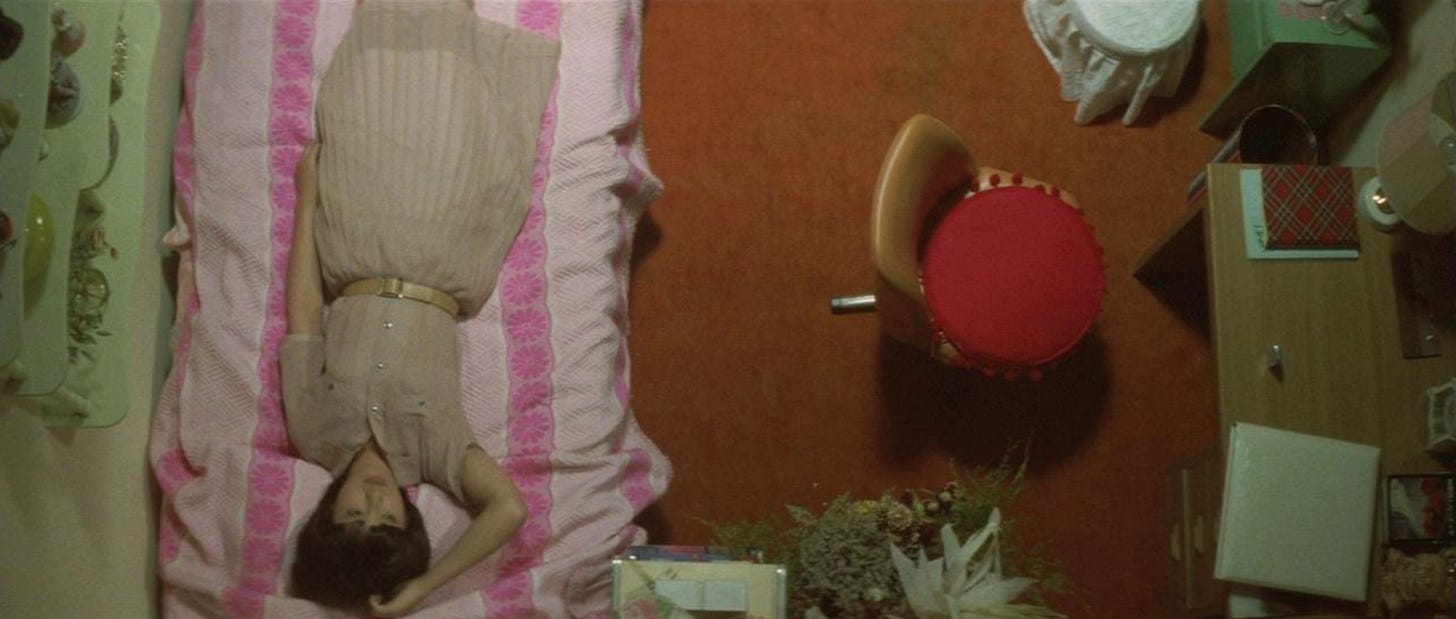When Eva Berezovsky, the romantic mind behind of pearl, messaged me on Instagram about a possible Substack collaboration, I did not pause to consider the matter. It was one of those decisions made before the full meaning of it even registered—an instinct, more than a thought. Two girls with really specific fixations, each particular and quiet, and yet perhaps that was the very point:
The preciousness of interior spaces (in film and beyond)
The power of material adornments (such as flowers)
How both of the above can mark people and moments
La Femme Nikita (1991)
I watched this movie blindly at the Angelika in New York City this year, and I was pleasantly surprised by how much it resonated. It’s an action movie from the 90s that was tense, funny, and devastating.
The movie follows Nikita, a young criminal who is sentenced to life in prison after a botched robbery. Instead of serving time, she’s recruited by a secret government organization and trained to become a deadly assassin. As she navigates her new life, she struggles with her dual identity — trying to maintain a normal life while carrying out covert missions.
Her personal relationships and growing sense of morality complicate her role as a killer, ultimately forcing her to confront her choices and fight for her freedom. She discovers that she can finally live the regular life she always believed she couldn't have — like going grocery shopping or furnishing a home — the longer she is forced to play this role.
These stills show Nikita's bedroom gradually evolving from an empty and impersonal setting to a space that reflects her distinctive persona and inner emotions, which include uncertainty, anger, and contentment.
Eva writes about personal space—the inner worlds we inhabit and how we inhabit them. I write about flowers in cinema—their fleeting yet powerful presence, how they fill a frame, transform a scene, mark time. So analyzing flower-filled bedrooms in film only feels right. Scroll on for my curated selection of movie stills, paired with reflections from Eva and me, as we explore how bedrooms function as intimate portraits of the characters who inhabit them.
Iris & Eva’s collective thoughts
In the spirit of experimentation, we decided to reflect on each bedroom independently before sharing our thoughts with one another. We embraced the possibility of aligned or divergent interpretations, knowing that this exercise would reveal just how deeply personal bedrooms are—and how they spark such subjective, often unexpected, responses. It’s a practice in seeing how a space can hold so many meanings, depending on who is looking, and what they bring with them.
3 Women (1977)
Iris: Shelley Duvall's portrayal of Millie Lammoreaux in 3 Women is captivating due to her awkwardness, aloofness, and self-absorbedness. Her unexplained fascination with canary yellow is evident in her bedroom, car, and clothing. Millie references fashion magazines in many scenes, suggesting she read about the current rage for the color. That said, she may later redesign her entire bedroom when she discovers a more fashionable color. She uses her personal space to convince others that she is a modern woman who can keep up with trends.
Eva: How satisfying that color-coordinated flowers span the nightgown, bedding, and nightstand tablecloth. The visual connection between the gown and the bedding/tablecloth feels like an ode to the notion of bedrooms as self-portraits. I am my bedroom, my bedroom is me. I wish to wear what my bedroom wears to feel maximum closeness to it. This kind of thinking. And the headboard's picket-fence-esque structure reinforces the floral power and presence.
Celine and Julie Go Boating (1974)
Iris: The flower bedroom scene is my favorite part of the movie because it exemplifies how Rivette manipulates time, place, and repetition to tell a multi-layered, intricate tale where the lines between performance, play, and reality are continuously blurred. There is a strong sense of ambiguity regarding what is real and what is really a game, yet there is also a moment of surreal delight. The excessive flowers can be interpreted as a visual motif representing the overwhelming sensation and meaning that Celine and Julie (along with the viewer) are attempting to navigate. I enjoy how minimalistic the bedroom décor is; it really accentuates the oversaturated hues of the flowers in the bedroom, which is a visual delight to watch.
Eva: I like the idea of the fresh and printed/fabric flowers working together here — the fresh flowers bringing an aliveness to the room, and the printed flowers on the headboard and curtains bringing a permanence or immortality to the floral presence. When the fresh flowers die, the printed ones will remain and remember them.
Claire’s Knee (1970)
Iris: I appreciate how cluttered, incomplete and unstaged these bedrooms look. This screenshot perfectly captures my own bedroom as I get ready and toss my clothes and books on a chair or my bed. Most people seem to prefer a clean, minimalist bedroom, and lived-in bedrooms are rarely found in movies these days. You can learn plenty about a person simply by looking around their bedroom, the items they choose to display on their shelves, or the color of their bed sheets.
Eva: The petiteness of these flowers feels striking. So does their position in a shadowed, dim zone. Amid this smallness and sunlessness, their offering of freshness and delight prevails. Bedroom adornments don’t need to be large or loud to impact the space.
Le Bonheur (1965)
Iris: Le Bonheur is my favorite Agnes Varda film, with a fairy-tale-like mise-en-scène and a horror story about a man's infidelity. Varda uses rose-colored glasses to set a romantic tragedy in a beautiful setting, with bouquets serving as obstructions. The vibrant colors and whimsical imagery contrast with the themes of betrayal and heartbreak, creating a sense of unease and contemplation.
Eva: While flowers typically complement the human experience as accessories in a room or emblems of a moment, here, they dominate compositionally, pushing human presence to a backseat. They also influence the color story in the rest of the still — their hues seep into their surroundings, reflective of their power over the spaces and people they interact with.
Slumber Party Massacre (1982)
Iris: The slasher film features a tranquil scene where despite strange noises and deaths, a sense of affection is evident among a friend group during their slumber party at home. They brush each other's hair and wonder if they'll ever be pretty while applying makeup, despite an escaped mass murderer near their home. This small scene is both significant and sad, as bedrooms serve as a barrier and secure haven.
Eva: Staring into these puffy, quilted flowers, there’s spookiness in the juxtaposition of such sweet, joyful bedding and the darkness that surrounds it. It surfaces fearing the dark as a child and seeking refuge in my bed — a protected island and safe haven that monsters could not access.
Take Me Away! (1978)
Iris: I visited San Francisco for the first time in August, and I had a wonderful time. Given that this movie, which I’d been wanting to see for a while, is set in San Francisco, I thought the timing couldn't be better. One of the film's protagonists, Kyoko, is resting comfortably in bed. Intimacy and vulnerability are expressed by her posture in bed. This image alone, with or without context, conveys feelings of sorrow, desire, love, and missing someone dearly.
Eva: Kyoko’s body language communicates a longing that inspires me to understand her floral bedding as a tool for grounding. A soft spot to land featuring illustrations of flowers, visions of nature. The floral bedding and the foliage at the bedside work together to build a place of peace.
The Green Ray (1986)
Iris: I apologize for including two Éric Rohmer films in this discussion, but I think the universe that he created is brilliant! Growing up, my bedroom was an oasis of security for me, where I could express myself through activities like taping posters or painting my walls. I never truly grasped the notion of a whole house; I rarely spent time in either the living room or the kitchen. My bedroom functioned as a living room, kitchen area, and workplace. The bedroom is more than simply a space; it is a whole home.
Eva: The headboard and bedding’s perfectly coordinated embodiment of the same printed flowers makes the bed a fully immersive experience. Every inch of this intimate zone for rest embraces the same vision — so sleeping or dwelling in bed becomes a full-on moment.
Love,
Iris and Eva
Films mentioned in order:
La Femme Nikita (1990) Dir. Luc Besson
3 Women (1977) Dir. Robert Altman
Celine and Julie Go Boating (1974) Dir. Jacques Rivette
Claire’s Knee (1970) Dir. Éric Rohmer
Le Bonheur (1965) Dir. Agnès Varda
Slumber Party Massacre (1982) Dir. Amy Holden Jones
Take Me Away! (1978) Dir. Nobuhiko Obayashi
The Green Ray (1986) Dir. Éric Rohmer



















